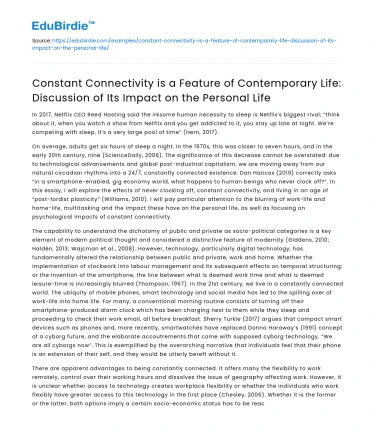In 2017, Netflix CEO Reed Hasting said the irksome human necessity to sleep is Netflix’s biggest rival; “think about it, when you watch a show from Netflix and you get addicted to it, you stay up late at night. We’re competing with sleep, it’s a very large pool of time” (Hern, 2017).
On average, adults get six hours of sleep a night. In the 1970s, this was closer to seven hours, and in the early 20th century, nine (ScienceDaily, 2006). The significance of this decrease cannot be overstated: due to technological advancements and global post-industrial capitalism, we are moving away from our natural circadian rhythms into a 24/7, constantly connected existence. Dan Hancox (2019) correctly asks “in a smartphone-enabled, gig economy world, what happens to human beings who never clock off?”. In this essay, I will explore the effects of never clocking off, constant connectivity, and living in an age of “post-fordist plasticity” (Williams, 2010). I will pay particular attention to the blurring of work-life and home-life, multitasking and the impact these have on the personal life, as well as focusing on psychological impacts of constant connectivity.
Save your time!
We can take care of your essay
- Proper editing and formatting
- Free revision, title page, and bibliography
- Flexible prices and money-back guarantee
The capability to understand the dichotomy of public and private as socio-political categories is a key element of modern political thought and considered a distinctive feature of modernity (Giddens, 2010; Haldén, 2013; Wajcman et al., 2008). However, technology, particularly digital technology, has fundamentally altered the relationship between public and private, work and home. Whether the implementation of clockwork into labour management and its subsequent effects on temporal structuring; or the invention of the smartphone, the line between what is deemed work time and what is deemed leisure-time is increasingly blurred (Thompson, 1967). In the 21st century, we live in a constantly connected world. The ubiquity of mobile phones, smart technology and social media has led to the spilling over of work-life into home life. For many, a conventional morning routine consists of turning off their smartphone-produced alarm clock which has been charging next to them while they sleep and proceeding to check their work email, all before breakfast. Sherry Turkle (2017) argues that compact smart devices such as phones and, more recently, smartwatches have replaced Donna Haraway’s (1991) concept of a cyborg future, and the elaborate accoutrements that come with supposed cyborg technology. “We are all cyborgs now”. This is exemplified by the overarching narrative that individuals feel that their phone is an extension of their self, and they would be utterly bereft without it.
There are apparent advantages to being constantly connected. It offers many the flexibility to work remotely, control over their working hours and dissolves the issue of geography affecting work. However, it is unclear whether access to technology creates workplace flexibility or whether the individuals who work flexibly have greater access to this technology in the first place (Chesley, 2006). Whether it is the former or the latter, both options imply a certain socio-economic status has to be reached to allow for flexibility at work. Those in professional occupations have more control over the temporal organisation of their work activities and the subsequent leisure-time surrounding it.
The flipside to being constantly connected is the struggle to unwind, due to the blurring of work and leisure time. Chesley’s (2006) research on work-home spillover highlights that individuals with a preference for communication technology rather than computational technology tend to experience more work-home spillover. As individuals tend to opt for smartphone technology over the passivity of computers, statistically more people have the potential to experience this dissolving of boundaries. However, Wajcman, Bittman and Brown (2008) argue that the control these devices give to the user to ‘switch off’ means that this spillover is less of an issue than originally thought. This is exemplified even further by individual proclivity for texting over calling. Perhaps this preference for texting over calling is a reaction to being ‘constantly connected’. By being only reachable by text, the onus of replying is given to the recipient and is not controlled by conversation conventions that are present on the phone.
Constant connectivity allows for flexibility within the temporal organisation of work time; however, it also allows for versatility in the creation and maintenance of personal relationships. For many, constant connectivity dissolves the issue of geographical location as a strain on relationships. Constant connectivity and social networks allow individuals to expand and maintain their circles to include weak ties and acquaintances but also serves to support strong and meaningful relationships (Baym, 2017). Caroline Haythornthwaite (2002) argues that ‘new media’ encourages the creation of latent ties, meaning that the internet produces the right environment for the formation of new relationships, transcends locality, often centring around individual and collective identity construction. Translating her work to 2019, this is exemplified by the everyday occurrence of communicating on social networks with strangers, often with common interests, and even the increasing popularity of dating apps.






 Stuck on your essay?
Stuck on your essay?

